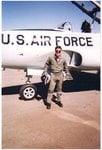I didn't say the 229 would have been an effective fighter aircraft! I only sayed it was allmost in production.
My source is the book from Reimar Horten
The RLM's E-stelle's order to build 40 pre production aircraft is dated 13 october '44, 2 months before the maiden of the V2 (indeed, my mistake, V1 was the glider which made several more flights and was captured by US troops) 20 were to be builded by gotha, 20 by klemm. Later this was changed, and gotha would have builded all the 40 aircraft.
Horten also tested a longer nose variant with a H-II with new center section to test the longer nose.
The cg on a flying wing is critical indeed. A lot of ballast was needed in the nose. But the armament wasn't installed yet, and with the longer nose of the V6, I think the problem could be solved, because the cockpit would be further to the front, and so creating a bigger moment. (V6 was to be a 2 seater/night fighter) Also, the planking of the wing was changed from a 17mm thick laminat to a 8 mm thick one. This would save 574kg.
On 14 july 44, the decision was taken, by gotha, to build the first 20 wings. A furniture workshop was contracted to do this. On 21 september '44 the Jäger sonderprogramm was made public and the furniture workshop could order through Gotha. Horten says it took 2500 hours to build a wing, I ask myself then why not more wings were captured by allied troops? If Gotha contracted a furniture workshop, it seems to me that they hadn't enough skilled woodworkers availeble,no?
Tom
My source is the book from Reimar Horten
The RLM's E-stelle's order to build 40 pre production aircraft is dated 13 october '44, 2 months before the maiden of the V2 (indeed, my mistake, V1 was the glider which made several more flights and was captured by US troops) 20 were to be builded by gotha, 20 by klemm. Later this was changed, and gotha would have builded all the 40 aircraft.
Horten also tested a longer nose variant with a H-II with new center section to test the longer nose.
The cg on a flying wing is critical indeed. A lot of ballast was needed in the nose. But the armament wasn't installed yet, and with the longer nose of the V6, I think the problem could be solved, because the cockpit would be further to the front, and so creating a bigger moment. (V6 was to be a 2 seater/night fighter) Also, the planking of the wing was changed from a 17mm thick laminat to a 8 mm thick one. This would save 574kg.
On 14 july 44, the decision was taken, by gotha, to build the first 20 wings. A furniture workshop was contracted to do this. On 21 september '44 the Jäger sonderprogramm was made public and the furniture workshop could order through Gotha. Horten says it took 2500 hours to build a wing, I ask myself then why not more wings were captured by allied troops? If Gotha contracted a furniture workshop, it seems to me that they hadn't enough skilled woodworkers availeble,no?
Tom

